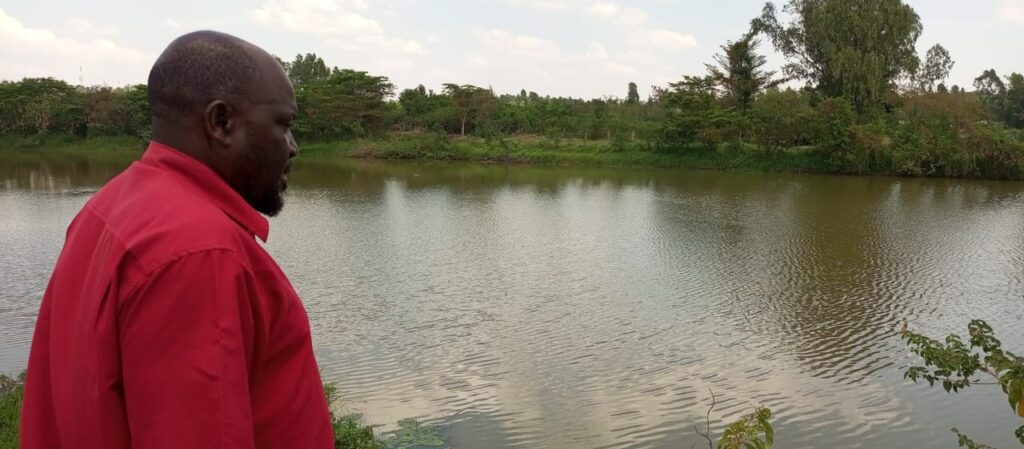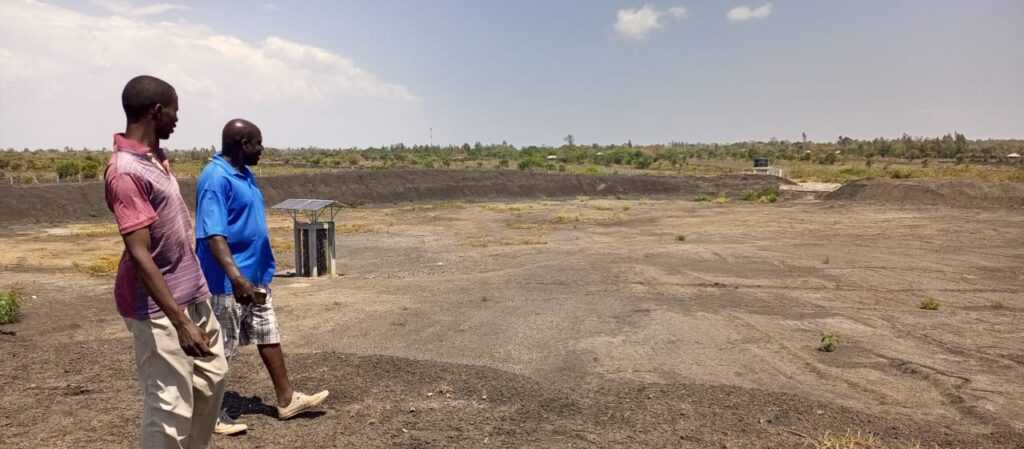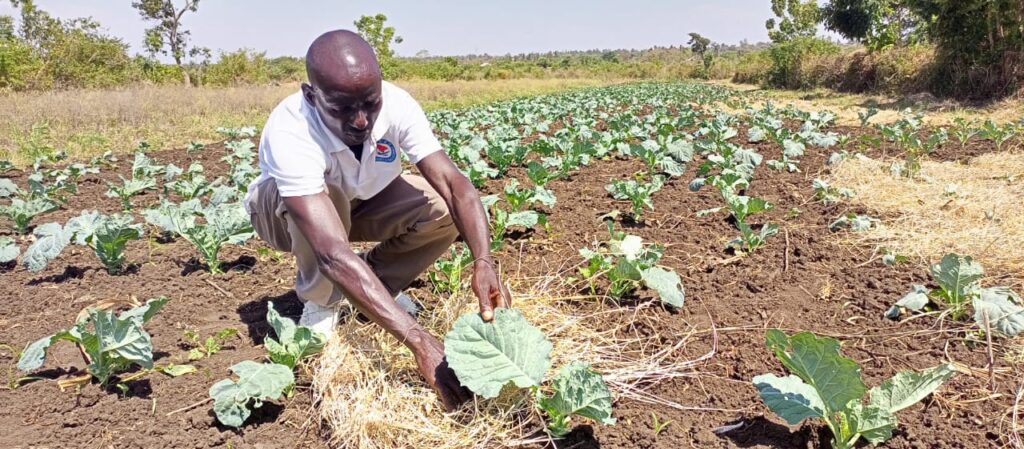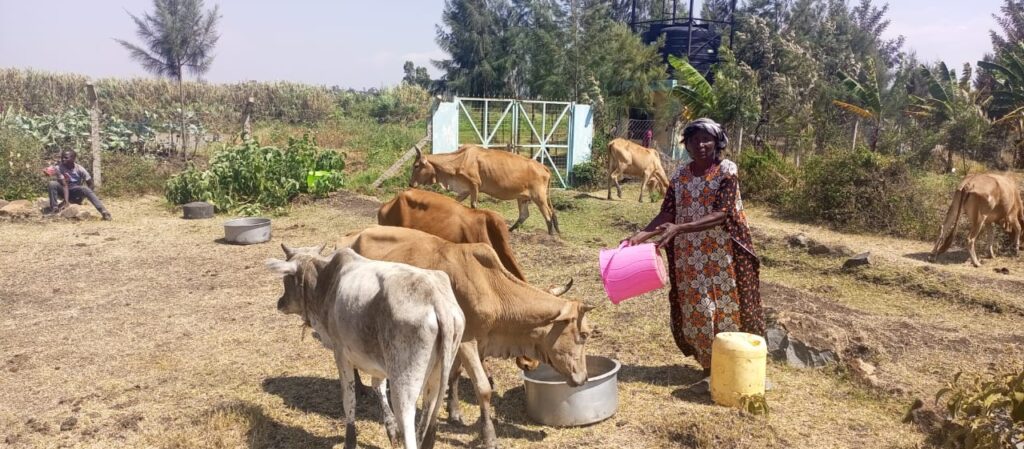It is Monday dawn, and as the sun rays pierce through the skies of Bondo town, Peter Otieno is already watering his vegetables.
This has been his routine for the past four years at his two-acre farm located at the main entrance to the town, along Bondo-Kisumu road.
Adjacent to the farm is Miruka Water Pan where he draws his water from.
The past 16 months have been so dry, and many farmers in the area have abandoned their farms, waiting for the rains.
But this is not the case for Otieno. “We do not need to wait for rains in order to produce food here,” he says.

Nine water pans
Otieno is one of the over 100 farmers benefiting from nine water pans spread across Bondo and Rarieda Sub Counties in Siaya County.
Previously, he would only produce during rainy season, but resort to other menial jobs to fend for the family during dry seasons when there is no water for crop production.
Despite its location at the shores of Lake Victoria, Siaya is one of the counties that face water crisis, especially during dry seasons.
According to experts, this is due to inadequate infrastructure to make the lake water accessible to residents for both domestic and agricultural use.
Two rivers; Nzoia and Yala also pass through the county, providing relief to farmers closer to them.
However, Rarieda and Bondo located closer to the lake shores remain the most disadvantaged as they lie in the areas with little access to water, with rains being the key source of water.
Rain water shortage
According to reports from the Meteorological Department, these two sub counties receive between 600mm to 800mm of rainfall annually, while Gem, Ugenya, Ugunja and Alego-Usonga Sub Counties which lie on the upper north of the county receive between 1, 600mm to 1, 800mm of rainfall.
This makes Rarieda and Bondo experience water scarcity, hence negatively impacting on food production.
According to World Bank, nine out of ten natural disasters are water-related, which cascade through food, energy, urban and environmental systems.
A country is defined as water-stressed if the per capita water availability is below 1700 metres cubic per year. Kenya is among the water-scarce countries across the world with per capita availability below 1000 cubic metres annually.
A 2015 study by University of Nairobi graduate Obat Gwena titled ‘Use of Geospatial Technology in rainwater harvesting’ indicates that Kenya is currently experiencing growing pressure on water resources caused by increasing water demand for agricultural, domestic and industrial consumption.
This, the study says, has been brought about due the effects of climate change and has necessitated the need to maximize and augment the use of existing or unexploited sources of fresh water.

Reprieve for farmers
And to bridge the water gap for agricultural production, Kenya Climate Smart Agriculture Project (KCSAP) has been supporting the community to establish water infrastructure to boost sustainable and resilience farming.
According to Willis Atyang, the KCSAP Coordinator, the project funded by the World Bank is aimed at increasing food productivity in a sustainable manner.
We had to look for the availability of land, the soil structure of the area, the landscape which can allow inlets and outlets
Willis Atyang, KCSAP Coordinator,
He says the intervention followed a proposal by the area residents following increased water scarcity.
“The proposal was approved at the county and national level, and then the implementation followed,” he said.
In setting up the water pans, areas were proposed by the residents, and then assessed by the County Advisory and County Project Steering Committees.
“We had to look for the availability of land, the soil structure of the area, the landscape which can allow inlets and outlets,” he said.
Affordability and sustainability of water pans
The construction of the pans involves assessing the suitability of the area to ascertain if it has the required type of soils and proper landscape.
The water pan has to be established in a plain ground where runoff can be trapped. The area must have clay soil which is good in water retention.
The solar pump is used to pump water into the tanks before being piped into the kiosks. Since our project aims at reducing greenhouse gases, we chose solar power to electric power
Mr Atyang’
“The more sandy the soil is, the more water is lost through seepage, so it is important to have clay which retains water for a long time,” said Atyang.
Additionally, he said the size and the depth of the pan is determined by the water need of the users.
The excavated soil is used as the wall around the pan, with small space left to allow inlet, and another for outlet to help for inflow of water runoff, and outflow when the pan is full.
In Siaya, the pans have been put up in community land, as they are meant to serve the community.
Each of the nine water pans have water kiosks, latrine, solar pump, animal watering trough and tanks.
The pans have capacities of between 17, 000 metre cubic to 40, 000 metre cubic of water, and can retain water for a whole dry season, serving over 100 farmers and another 3, 000 households depending on the water for domestic use.
“The solar pump is used to pump water into the tanks before being piped into the kiosks. Since our project aims at reducing greenhouse gases, we chose solar power to electric power,” he said.

Farmers draw water from the pans through pumps, or physically using containers, as is convenient with the distance their farms are from the pans.
He noted that water pans are cost effective as they are easy to maintain.
“It is the initial investment costs of excavation, fencing, and provision of the supportive accessories which is costly. After that, the beneficiaries only need to provide minimum maintenance requirements such as preserving the environment and providing security to the facilities,” said Atyang.
Otieno is the Chairman of Miruka water pan, and produces kales and traditional vegetables from his parcel adjacent to the pan.
Here, he says there are about 20 farmers directly benefiting from the water pan.
“Some people do tree seedlings, while many of us do vegetables because of the good returns,” he says.
Most of the vegetables, he says, are sold to small scale traders who resell to Bondo town residents.

Bonface Okelo is another farmer adjacent to the water pan. He does tomatoes in his two and a half acre parcel.
“These days I have continuous production, as I segment the farm and plant at intervals,” he says.
With water available, my tomatoes mature within 75 to 90 days, and one acre can produce upto 30 crates within the two months harvesting period.
About 30 kilometres in Okela village, Rarieda Sub County is Achar water pan.
Dan Ochieng, a retired primary school teacher is one of the farmers utilizing this resource, and the chairman of the pan management committee.
So many people have abandoned farming because rains are not enough. And for those close to the water pan, we just thank God
Dan Ochieng, farmer
After retirement in 2017, he purchased about six acres of land near the pan and begun commercial farming. He does maize and vegetables.
“So many people have abandoned farming because rains are not enough. And for those close to the water pan, we just thank God,” he says.
He sells most of his produce to the neighbouring schools, and he says he is comfortable in retirement.
Harrison Ojwang is another beneficiary of this water pan. The 52-year-old resident of Uyoma Kokiri has been farming for the past 30 years.
“Previously I used to do much of maize, but now I am concentrating on tomatoes,” he said.
Another 25 kilometres is Adhiri water pan in Ogango village, Rarieda Sub County.
Raphael Otieno has been engaging in production of kales using water from this pan since 2019 after returning home from employment in Kilifi.
“When I came home and saw this resource, I ventured into farming and I have not looked back,” he said.
Just like his colleagues in the other water pans, Otieno says there is ready market for his produce, and with the availability of water, he is able to produce throughout the year.

How water pans work
According to Felix Ono, an Agricultural Engineer, water pans are some of the traditional means of storing water.
“A water pan basically involves excavating reservoirs where you can store the runoff during rainy season, to utilize during the dry season,” he says.
Before putting up a water pan, Ono says you have to know the water need of the community.
“Even though water pan is done for irrigation purposes, we do not close our eyes to the domestic needs and animals within the community,” he said.
Bondo and Rarieda are water scarce, and with time, there will be need to have a water pan in each location so as to make water efficient
Felix Ono, Agricultural Engineer
The need assessment hence informs the size of the pan, and the design, to ensure that it meets its purpose.
Mr Ono says many of the water pans in Siaya are able to serve the residents throughout the dry seasons, but with the continued impacts of Climate Change leading to unpredictable rainfall, some of the reservoirs have been drying up.
He noted that during long droughts, people move from far areas to have a share of the water pans, hence stretching the demand for water.
“Bondo and Rarieda are water scarce, and with time, there will be need to have a water pan in each location so as to make water efficient,” he said.
According to Engineer Ono, it takes Sh500 to construct one cubic metre capacity in water pan.
“You can use this to budget for the capacity of the pan that you need,” he says.
He however notes that due to the need of the community, other auxiliary facilities can be costed individually.
“For example, in the pans in Siaya, we have toilets, water troughs, water tanks, fence, among other facilities which have different sizes, hence different costing,” he adds.
